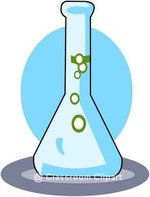Rutherfordium
|
|
| |||||
| Known properties | |||||
|---|---|---|---|---|---|
| Name, Symbol, Number | Rutherfordium, Rf, 104 | ||||
| Chemical series | Transition metals | ||||
| Group, Period, Block | 4, 7, d | ||||
| Appearance | unknown | ||||
| Atomic weight | [261] amu | ||||
| Electron configuration | probably [Rn]5f14 6d2 7s2 | ||||
| e- 's per energy level | 2,8,18,32,32,10,2 | ||||
| State of matter | Presumably a solid | ||||
Rutherfordium (Eka-Hafnium) is a chemical element in the periodic table that has the symbol Rf and atomic number 104. This is a highly radioactive synthetic element whose most stable isotope has a half life of less than 70 seconds. This element therefore is not used for anything and little is known about it. Rutherfordium is the first transactinide element and it is predicted to have chemical properties similar to hafnium.
History
Rutherfordium (named in honor of Lord Rutherford of Nelson) was reportedly first synthesized in 1964 at the Joint Nuclear Research Institute at Dubna (U.S.S.R.). Researchers there bombarded plutonium with accelerated 113 to 115 MeV neon ions and claimed that they detected nuclear fission tracks in a special type of glass with a microscope which indicated the presence of a new element.
In 1969 researchers at the University of California, Berkeley synthesized the element by subjecting californium-249 and carbon-12 to high energy collisions. The UC group also stated that they could not reproduce the earlier synthesis by Soviet scientists.
This resulted in an element naming controversy; Since the Soviets claimed that it was first detected in Dubna, Dubnium (Db) was suggested, as was Kurchatovium and symbol Ku for element 104, in honor of Igor Vasilevich Kurchatov (1903-1960), former Head of Soviet Nuclear Research. The Americans, however, proposed Rutherfordium (symbol Rf) for the new element to honor Ernest Rutherford, a noted nuclear physicist from New Zealand. The International Union of Pure and Applied Chemistry (IUPAC) adopted Unnilquadium (symbol Unq) as a temporary name for this element. However in 1997 they resolved the dispute and adopted the current name.
References
- Los Alamos National Laboratory Rutherfordium (http://periodic.lanl.gov/elements/104.html)
External links
- WebElements.com - Rutherfordium (http://www.webelements.com/webelements/elements/text/Rf/index.html)
- EnvironmentalChemistry.com - Rutherfordium (http://environmentalchemistry.com/yogi/periodic/Rf.html)


